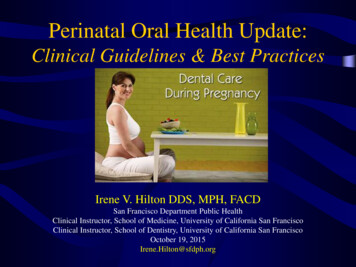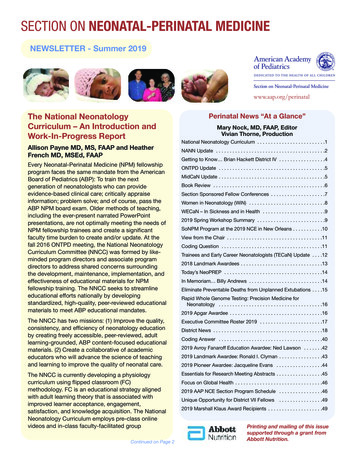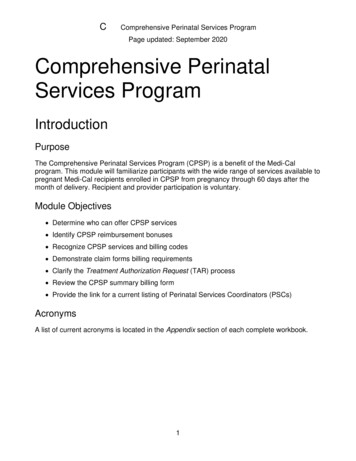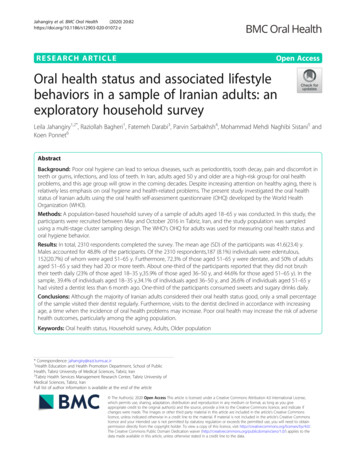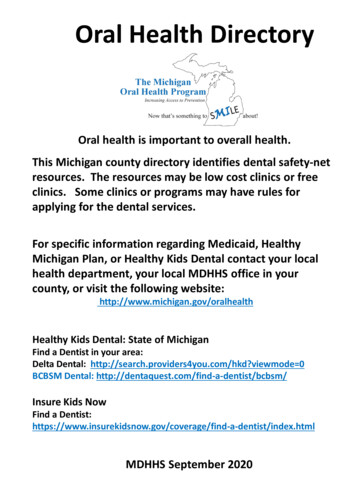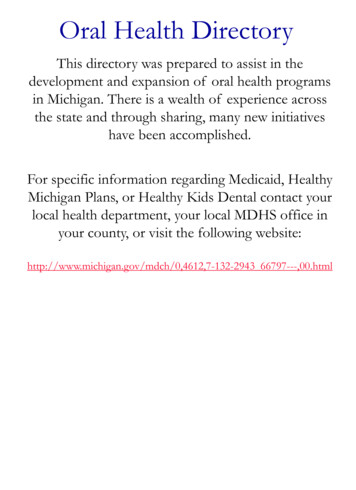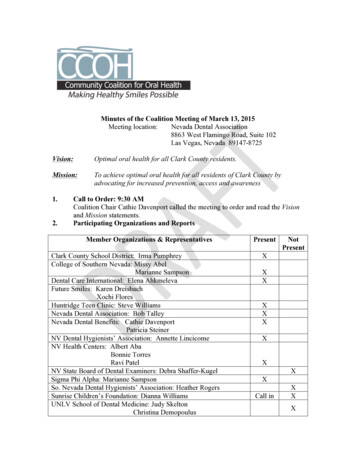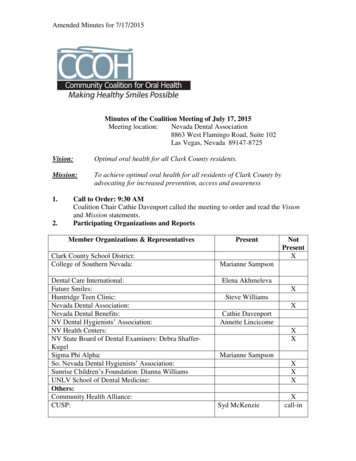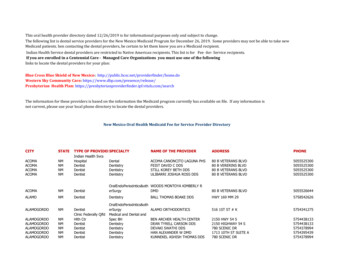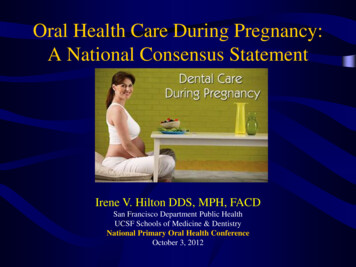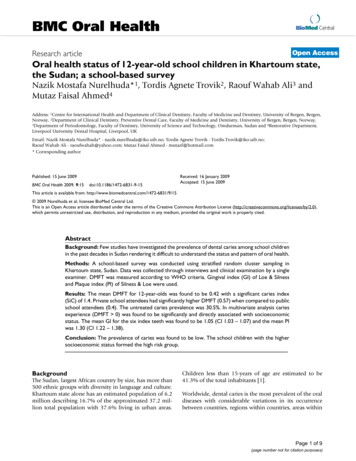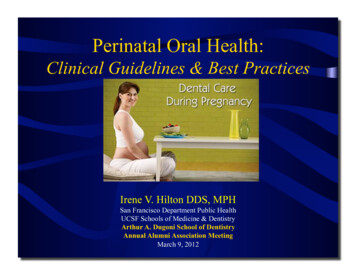
Transcription
Perinatal Oral Health:Clinical Guidelines & Best PracticesIrene V. Hilton DDS, MPHSan Francisco Department Public HealthUCSF Schools of Medicine & DentistryArthur A. Dugoni School of DentistryAnnual Alumni Association MeetingMarch 9, 2012
Objectives Understand effect of maternal oral health onfamilies Describe why pregnancy provides opportunityto provide oral health interventions for women Learn elements of clinical prevention andtreatment guidelines for pregnant women Learn practical tips for making dental caremore comfortable for patient AND provider
Impact of Maternal Oral Healthon Families
Periodontal Disease
Etiology of Periodontitis Toxic products from bacteria in gingivalcrevice induce immune-systemmodulated processes that result indestruction of supporting bone Chronic disease process. Bone loss canoccur in “episodes” throughout life Essentially an inflammatory process
Etiology of Periodontitis Multiple gram-negative speciesconsistently associated withperiodontitis– Porphyromonas gingivalis– Actinobacillus actinomycetemcomitans
Disease Response toBacterial HighTNFαIL-6IL-1βIFN-gPGE2MMPs
Periodontal Disease Definition Moderate- At least two teeth with interproximal attachment loss of 4 mm orat least two teeth with 5 mm of pocketdepth at inter-proximal sites (CDC, AAP)
Moderate Periodontal Disease Prevalence(1 sites with Loss of Periodontal Attachment (LPA) 4 mm)605018-2425-3435-4445-5455-6465-7440% 302010018-2425-3435-4445-54AgeSource: NHANES 3 (1989-94), US Population55-6465-74
Epi: Attachment loss 6mm by -4445-54Source: NHANES III (1989-94), US Population44-6454-74
Lack of Consistency Early studies were not consistent withclinical criteria– Impacts disease prevalence results– Makes it hard to compare studies– Definition of periodontitis may determinestatistical significance of the associationbetween periodontitis and adversepregnancy outcomes (Kassab et al, 2011)
Periodontitis & Pregnancy Case control (Offenbacher et al 1996, Goepfert et al 2004) Prospective (Jeffcoat 2001, Lopez 2002, Offenbacher 2006,Pitiphat et al 2007, Saddki et al 2007) Both showed association betweenperiodontitis and LBW, pre-term birth orpreclampsia Known risk factors- smoking, race,alcohol, entry into care, maternal ageetc. controlled
Definitions Preclampsia (ACOG)– Increased diastolic blood pressure– Proteinuria– HELLP syndrome (hemolysis, elevatedliver enzymes, and low platelet counts) Prematurity (WHO)– 23rd to 37th weeks of gestation
Meta-Analysis of Associations(Matevosyan, 2011) 125 studies between 1998-2010 Maternal periodontal disease remainsassociated with perinatal adverseoutcomes– Preclampsia– Prematurity
Periodontitis & PregnancyMechanisms Circulating periodontal bacteria induceactivation of maternal immune responseslead to cytokine production, release ofprostaglandins (Offenbacher 1998) Periodontal bacteria & toxins cross theplacental barrier colonize feto-placental unit,trigger inflammatory response and pretermbirth (Bobetsis 2006)– Studies find porphyromonas gingivalis in amnioticfluid
Inflammation Pregnant women with periodontitis hadhigher C-reactive protein (C-RP) levelsthan periodontally healthy (Pitiphat et al, 2006) Plasma prostaglandin E(2), Interleukin(IL)-1 beta, Tumor necrosis factor-a PGE2 is a key mediator in labor/ birthprocess
Randomized Clinical Trials Can prove or disprove causalityAssociation vs. causalityControl vs. InterventionMost intervention was in 2nd tri-mesterS & RP w/ anesthesia
OPT&Results Obstetrics and Periodontal Therapy (OPT) Study– Nov. 2006 NEJM– 410 control, 413 Tx group @ 4 US sites– No significant difference between Tx and control groups innumber of pre-term births ( 37 weeks) MOTOR– Sept. 2009 Obstet Gynecol– 1,800 subjects @ 3 US sites– No significant differences when the two groups werecompared for obstetric or neonatal outcomes
Meta-Analysis of ClinicalIntervention Trials Journal American Dental Association– 2010 Dec141(12): 1423-1434 British Medical Journal– 2010 Dec 29;341:c7017 Journal of Clinical Periodontology– 2011 Oct;38(10):902-14. No effect on adverse birth outcomes
At the same time Han et al. Term Stillbirth Caused by OralFusobacterium nucleatum. Obstet Gynecol2010;115:442–5.– F. nucleatum isolated from placenta and stillborn fetus.Examination of microbial flora from mother identified thesame clone in her subgingival plaque
Underlying MolecularMechanism Research Continues Periodontal pathogen Actinobacillusactinomycetemcomitans induces celldeath in human placental trophoblasts (Liet al. Placenta 2011)
What we know Association probably relates to inflammationin causal pathways Periodontitis in pregnancy is still a chronicdisease/pathological state Periodontal health has a value in itselfregardless whether there is a link withsystemic disease
Routine Dental Treatment Safe Flip side is intervention studies showedroutine dental treatment of periodontitisis safe during pregnancy Other routine dental care/proceduresalso safe (Michalowicz et al, 2008)
Dental Caries Dental caries, once acquired, is a chronic,ongoing disease PROCESS that must bemanaged throughout the life cycle Cavities are the RESULT or final diseaseendpoint of the dental caries process Multifactorial disease Primary cariogenic organisms– Strep mutans & sobrinus– Lactobacilli
Acquisition ofCaries Causing Bacteria Maternal transmission of strep mutansduring normal activities (feeding etc.)(Berkowitz et al 1981, 1985, 2003, 2006. Caufield et al 1993, 1995,2000, 2003, 2005) Highest fidelity of transmission withmother DNA analysis shows same sequence inmaternal and infant strep mutans
Strep Mutans Transmission
Epi: Prevalence of CoronalCaries Among Dentate AdultsNHANES 1999- 2004
Early Childhood Caries Loss of function Failure to thrive (Elice and Fields 1990, Acs et al. 1999) Unequal expenditure of resources forER and hospital-based treatment (Ettelbrick,Webb and Seale 2000, Griffen et al. 2000) Morbidity form treatment Lifetime of caries (Weinstein 1998)
Early Childhood Caries Disparities% 2-4 y/o Untreated DecayData Source: NHANES, 1999-2004, NCHS/CDC.
Influences on Children's Oral HealthFisher-Owens et al.Pediatrics 2007
MomChild
Maternal Influence Diet Level of home care Importance of primary teeth & oralhealth Genetic & transmissibility components
Pregnancy Presents anOpportunity Introduce risk reduction & selfmanagement strategies for mom andchild Stabilize maternal periodontal status Impact the cycle of s. mutans maternaltransmission
Opportunity At risk populations in contact with healthcare delivery system more frequentlythan usual Pregnant women may be interested intheir oral health & open to healtheducation messages May be only time have any type ofdental insurance coverage
Dental Visits: 2002 PRAMSPregnancy Risk Monitoring System (CDC)
Dental Care Utilization Pregnant women receive dental careless frequently than the general femalepopulation (Jiang et al, 2008) Women with both private dentalinsurance and Medicaid coverage utilizedental care more frequently when theyare not pregnant than when they arepregnant (Iida 2009, Thoele 2008)
Clinical Interventions
Guidelines Systematically developed statements toassist practitioner and patient decisions aboutappropriate health care for specific clinicalcircumstances (IOM, 1990) Recommendations based on evidence fromrigorous systematic review and synthesis ofpublished medical literature Define practices that meet the needs of mostpatients in most circumstances
2006 NY State GuidelinesPhysician section:Importance of oralhealth to pregnancy,responses to commonconcerns by dentistsDentist section:Evidence basedrecommendations andprotocols for clinicaltreatment of pregnantwomen
“Because pain was so great she took ‘excessive doses’(Tylenol) resulting in toxicity to her and her baby. At the time shewas approximately 29 weeks pregnant. The baby died fromliver toxicity. My patient suffered acute liver failure and wasflown to Pittsburgh expecting a liver transplant.”
2010 California Guidelines California DentalAssociationFoundation American College ofObstetricians andGynecologists,District IX
Need For Guidelines 2006 California Maternal and Infant HealthAssessment (MIHA) data showed 35.1%pregnant women had a dental visit 53.8% stated they had an oral health problemduring pregnancy, but of those 62.3% did notvisit the dentist while pregnant Desire among both dentists and ObGyn’s forprofessional guidelines and education
Need For Guidelines- Patient Attitude towards dental treatment whilepregnant Concerns regarding dental care notverbalized to perinatal providers Belief poor oral health status duringpregnancy is normal Low awareness of importance ofmaternal oral health and relationship toinfant’s long-term oral health
Need For GuidelinesPerinatal Providers Lack knowledge about the importanceof oral health status Not performing routine assessment andreferral of pregnant women into dentalcare Not enough information to providerationale why attending dental visits isimportant & respond to concerns
Need For GuidelinesDental Providers Insufficient training combined with lackof experience treating pregnant womenin dental school Fear of malpractice suit if somethinggoes wrong with a patient’s pregnancy Concerns about the safety ofprocedures Addressing patient perceptions of risk
Malpractice Myth TDIC- ten states & 17,000 insureddentists Reports one claim in the past 15 yearsblaming adverse birth outcome ondental treatment– No evidence for claim
Guidelines Development Process Advisory committee Nationally recognized experts– Periodontology, medicine (FM/Ob-Gyn/Radiology), ethics, environmental &occupational health, public health,cariology Experts write guidelines- best availableevidence- 250 references! Guidelines reviewed & disseminated
Role of Perinatal Provider Ask about and assess oral health Facilitate oral health examination byidentifying dental provider Facilitate treatment by providing writtenmedical clearance Ask if any concerns & address. Informdental care is safe and effective
Role of Dental Provider Same as any comprehensive carepatient Exam & risk assessment Surgical intervention/treatmentappropriate disease level Preventive activities including riskreduction self-management strategies Recall
Oral Conditions Unique toPregnancy Pregnancy Gingivitis Pregnancy Epulis Erosion from morning sickness
Guidelines Consensus StatementPrevention, diagnosis and treatment of oraldiseases, including needed dental radiographsand use of local anesthesia, are highlybeneficial and can be undertaken duringpregnancy with no additional fetal or maternalrisk when compared to the risk of not providingcare.Pregnancy is not a reason to defer routinedental care or treatment of oral health problems.
Key Findings No evidence relating early spontaneousabortion to first trimester oral health care ordental procedures. Not necessary to have approval from theprenatal care provider for routine dental careof healthy patient. Control of oral diseases in pregnant womenhas potential to reduce transmission of oralbacteria from mothers to their children.
Consult Indicated Co-morbidities that may affect managementdiabetes, pulmonary issues, heart or valvulardisease, hypertension, bleeding disorders, orheparin-treated thrombophilia Nitrous oxide needed for dental treatment Intravenous sedation or general anesthesianeeded
Dentist’s Concerns forSurgical Intervention/treatment X-raysEmergency careNitrous oxideLocal anesthesiaRestorative materialsMedicationsPerception of patient discomfort
Adverse Pregnancy Outcomes Risk of pregnancy loss before 20weeks- 15 - 25%. Most are notpreventable Risk of teratogenecity- up to 10 weeks– Rate of malformations - 3 to 4%
X-rays Radiographic imaging notcontraindicated– Very low levels of radiation– Thyroid collar and abdominal apron Should be utilized as required tocomplete full examination, diagnosisand treatment plan Standard of care
Emergency Care Provide emergency/acute care at anytime during pregnancy as indicated byoral condition
Nitrous Oxide Should be limited to situations wheretopical and local anesthetics areinadequate & care is essential Cost-benefit analysis Pregnant women require lower levels ofnitrous oxide to achieve sedation
Local Anesthesia Local anesthetic with epinephrine whenclinically indicated
Restorative Materials Amalgam– No evidence of harmful effect in populationbased studies and reviews (FDA 2009, CDC, NCI)– No additional risk if standard safe amalgampractices are used Resins– Short-term exposure associated withplacement has not been shown to havehealth risk; data lacking on the effects oflong-term exposures
Drugs in PregnancyPhysiological Considerations Changes in pulmonary, gastrointestinaland peripheral blood flow can alter drugabsorption Hepatic changes can alterbiotransformation of drugs by the liverand clearance
Drugs in Pregnancy Study of W. VA pregnant women (Glover etal. 2003)– Average 1.14 prescription drugs, excludingvitamins and iron– Average of 2.95 over-the-counter drugs Tylenol, Tums, cough drops– Nearly half (45%) used herbal agents Peppermint, cranberry
Drugs in PregnancyNot to Exceed Daily Doses Most are Category B (no adequate studiesanimals or , amoxicillin, clindamycinNystatin Category C (effects on animals & no studieson women)– Chlorhexidine rinse– Codeine
Drugs in Pregnancy- Avoid NSAIDS (1st & 3rd) Erythromycin estolate Tetracycline
Patient Comfort Head higher thanfeet Upper archtreatment early inpregnancy beforelower arch Morning orafternoonappointmentpreference Breaks
Postural Considerations 3rd trimesterPosturalhypotensivesyndrome IVC impingement byweight of fetus Turn on side torestore circulation
Chemotherapeutics Fluoride Chlorhexidine (CHX)- non-alcoholicversion available Xylitol No over the counter mouth rinses withalcohol (Listerine 20% alcohol)
The Caries BalancePathological Factors Acid-producing bacteria Sub-normal saliva flowand/or function Frequent eating/drinkingof fermentable carbohydrateCariesProtective FactorsProtectiveFactorsflow andcomponents Saliva Fluoride, calcium, phosphate Antibacterials: - chlorhexidine,iodine?, xylitol, new?No Caries
Fluoride OTC & Rx options
Chlorhexidine Suppress s. mutans & periodontal pathogens Italian 30 month study- delayed s. mutanscolonization in children after intervention withmother during last 3 months of pregnancy(Brambilla et al. JADA 1998) Patients rinse prior to appointment After birth- 1 week of CHX followed by 3weeks of OTC Fl rinse (Spolsky et al. CDA Journal 2007) Cost/insurance coverage
Xylitol Naturally occurring sugar derived frombark of birch tree Suppresses s. mutans (Hildebrandt 2000) Studies show decreases transmission s.mutans (Soderling et al, 2000) Only way to insure therapeutic dose isdispense
Self Management Goals Basedon Risk Assessment Increasing & maintaining protectivefactors Reducing risk factors
Patient Education Materials Review for readinglevel and culturalappropriateness Keep materials brief Include larger print Focus on howMother’s oral healthaffects baby DVD’s
Motivational Interviewing Get mothers to talk you listenGive choices (key, key, key)Acceptance facilitates changePressure to change facilitatesresistance Sensitivity to culture, SES Small steps
Resources Perinatal Oral Health http://www.cdafoundation.org/library/docs/news 030110a.htm http://cda.org/publications/journal of the california dental association/archive & search– September 2010 issue
What now? Engage perinatal providers in yourcommunity Private vs. Public insurance– Limited scope– Ends two months after birth
Conclusion Pregnant women are experiencing anormal biological state and ethicallydeserve the same level of care as anyother patient Lack of knowledge and anecdotalconcerns influenced dental practice Evidence base shows appropriatedental care is necessary and safe
Our Goal
insurance and Medicaid coverage utilize dental care more frequently when they are not pregnant than when they are pregnant (Iida 2009, Thoele 2008) . Malpractice Myth TDIC- ten states & 17,000 insured dentists Reports one cl
